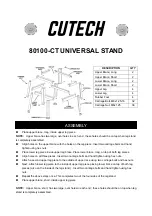
FORMATTING YOUR LACIE USB KEY
You may use Disk Management (Windows) or Disk Utility (Mac) to format and partition your LaCie USB Key.
Please note that formatting any storage device will delete all of its data. Therefore, LaCie highly recommends
copying all data stored on your LaCie USB Key before creating new partitions. Do not forget to copy the LaCie
software utilities bundled with your USB Key.
Important Info:
Formatting and partitioning your LaCie storage device will delete all data stored on the
existing volumes. LaCie highly recommends copying all data before using a formatting utility.
OPTIONAL FORMATTING AND PARTITIONING
Please read this section carefully before formatting and partitioning your LaCie storage device.
ABOUT FILE SYSTEM FORMATS
Windows Users
FAT 32:
FAT is an acronym for File Allocation Table, which dates back to the beginnings of DOS programming.
Originally, FAT was only 16 bits, but after the second release of Windows 95 it was upgraded to 32 bits, hence
the name FAT 32. In theory, FAT 32 volume sizes can range from less than 1MB all the way to 2TB.
It is the native file system of Windows 98 and Windows Me, and is supported by Windows 2000, Windows XP,
Windows Vista, and Windows 7. When FAT 32 is used with Windows 2000, Windows XP, Windows Vista, and
Windows 7 however, volume size is limited to 32GB (by the Windows partition utility, i.e. Disk Manager), and the
individual file size is limited to 4GB.
NTFS:
This acronym stands for New Technology File System, and it is the native file system for Windows NT,
2000, XP, Vista, and 7. NTFS offers several features that are not available with FAT 32: file compression,
encryption, permissions, auditing, and mirroring drives. The minimum supported volume size for NTFS is 10MB
with a maximum of 2TB when initialized in the MBR format. The more recent GPT format does not assign limits
to file or partition sizes. Volumes created in NTFS are native read and write for Windows NT, 2000, XP, Vista, and
7. Earlier versions of Windows and Mac OS X 10.5 or higher may read and write to the NTFS partitions with the
help of third-party drivers.
See the table below for a comparison of NTFS and FAT 32.
Windows File System Formats
Use NTFS if:
…you will be using the storage device only with Windows XP, Vista, and 7 since performance will be enhances
when compared to FAT 32. This file system is compatible in read-only mode with Mac OS 10.3 and higher.
Use FAT32 if:
…you will be using your storage device with both Windows and Mac computers. Maximum single file size is
limited to 4GB.
LaCie
9










































